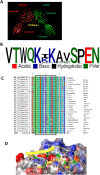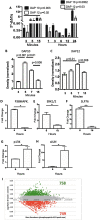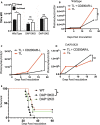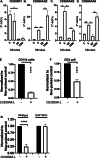CD200 Immune-Checkpoint Peptide Elicits an Anti-glioma Response Through the DAP10 Signaling Pathway
- PMID: 33829411
- PMCID: PMC8609078
- DOI: 10.1007/s13311-021-01038-1
CD200 Immune-Checkpoint Peptide Elicits an Anti-glioma Response Through the DAP10 Signaling Pathway
Erratum in
-
Correction to: CD200 Immune-Checkpoint Peptide Elicits an Anti-glioma Response Through the DAP10 Signaling Pathway.Neurotherapeutics. 2021 Jul;18(3):2131. doi: 10.1007/s13311-021-01062-1. Neurotherapeutics. 2021. PMID: 33929711 Free PMC article. No abstract available.
Abstract
Numerous therapies aimed at driving an effective anti-glioma response have been employed over the last decade; nevertheless, survival outcomes for patients remain dismal. This may be due to the expression of immune-checkpoint ligands such as PD-L1 by glioblastoma (GBM) cells which interact with their respective receptors on tumor-infiltrating effector T cells curtailing the activation of anti-GBM CD8+ T cell-mediated responses. Therefore, a combinatorial regimen to abolish immunosuppression would provide a powerful therapeutic approach against GBM. We developed a peptide ligand (CD200AR-L) that binds an uncharacterized CD200 immune-checkpoint activation receptor (CD200AR). We sought to test the hypothesis that CD200AR-L/CD200AR binding signals via he DAP10&12 pathways through in vitro studies by analyzing transcription, protein, and phosphorylation, and in vivo loss of function studies using inhibitors to select signaling molecules. We report that CD200AR-L/CD200AR binding induces an initial activation of the DAP10&12 pathways followed by a decrease in activity within 30 min, followed by reactivation via a positive feedback loop. Further in vivo studies using DAP10&12KO mice revealed that DAP10, but not DAP12, is required for tumor control. When we combined CD200AR-L with an immune-stimulatory gene therapy, in an intracranial GBM model in vivo, we observed increased median survival, and long-term survivors. These studies are the first to characterize the signaling pathway used by the CD200AR, demonstrating a novel strategy for modulating immune checkpoints for immunotherapy currently being analyzed in a phase I adult trial.
Keywords: CD200AR; GBM; Immune checkpoints; Immunotherapy; Phase 1.
© 2021. The American Society for Experimental NeuroTherapeutics, Inc.
Figures






Similar articles
-
CD200 Checkpoint Reversal: A Novel Approach to Immunotherapy.Clin Cancer Res. 2020 Jan 1;26(1):232-241. doi: 10.1158/1078-0432.CCR-19-2234. Epub 2019 Oct 17. Clin Cancer Res. 2020. PMID: 31624103
-
A Systematic Review of the Tumor-Infiltrating CD8+ T-Cells/PD-L1 Axis in High-Grade Glial Tumors: Toward Personalized Immuno-Oncology.Front Immunol. 2021 Sep 17;12:734956. doi: 10.3389/fimmu.2021.734956. eCollection 2021. Front Immunol. 2021. PMID: 34603316 Free PMC article.
-
7aaRGD - a novel SPP1/integrin signaling-blocking peptide reverses immunosuppression and improves anti-PD-1 immunotherapy outcomes in experimental gliomas.J Exp Clin Cancer Res. 2025 Apr 25;44(1):132. doi: 10.1186/s13046-025-03393-9. J Exp Clin Cancer Res. 2025. PMID: 40281508 Free PMC article.
-
ACT001 reduces the expression of PD-L1 by inhibiting the phosphorylation of STAT3 in glioblastoma.Theranostics. 2020 May 1;10(13):5943-5956. doi: 10.7150/thno.41498. eCollection 2020. Theranostics. 2020. PMID: 32483429 Free PMC article.
-
Combinatorial approaches to effective therapy in glioblastoma (GBM): Current status and what the future holds.Int Rev Immunol. 2022;41(6):582-605. doi: 10.1080/08830185.2022.2101647. Epub 2022 Aug 8. Int Rev Immunol. 2022. PMID: 35938932 Review.
Cited by
-
Identification of Ferroptosis-Related Biomarkers for Prognosis and Immunotherapy in Patients With Glioma.Front Cell Dev Biol. 2022 Jan 31;10:817643. doi: 10.3389/fcell.2022.817643. eCollection 2022. Front Cell Dev Biol. 2022. PMID: 35174152 Free PMC article.
-
Breed-Associated Differences in Differential Gene Expression Following Immunotherapy-Based Treatment of Canine High-Grade Glioma.Animals (Basel). 2024 Dec 26;15(1):28. doi: 10.3390/ani15010028. Animals (Basel). 2024. PMID: 39794971 Free PMC article.
-
Trap and ambush therapy using sequential primary and tumor escape-selective oncolytic viruses.Mol Ther Oncolytics. 2023 May 22;29:129-142. doi: 10.1016/j.omto.2023.05.006. eCollection 2023 Jun 15. Mol Ther Oncolytics. 2023. PMID: 37313455 Free PMC article.
-
Targeting CD200 in Breast Cancer: Opportunities and Challenges in Immunotherapeutic Strategies.Int J Mol Sci. 2024 Dec 26;26(1):115. doi: 10.3390/ijms26010115. Int J Mol Sci. 2024. PMID: 39795972 Free PMC article. Review.
-
Cancel cancer: The immunotherapeutic potential of CD200/CD200R blockade.Front Oncol. 2023 Jan 23;13:1088038. doi: 10.3389/fonc.2023.1088038. eCollection 2023. Front Oncol. 2023. PMID: 36756156 Free PMC article. Review.
References
-
- Gorczynski R, Chen Z, Kai Y, Lee L, Wong S, Marsden PA. CD200 is a ligand for all members of the CD200R family of immunoregulatory molecules. J Immunol. 2004;172(12):7744–7749. - PubMed
Publication types
MeSH terms
Substances
Grants and funding
LinkOut - more resources
Full Text Sources
Other Literature Sources
Medical
Molecular Biology Databases
Research Materials

